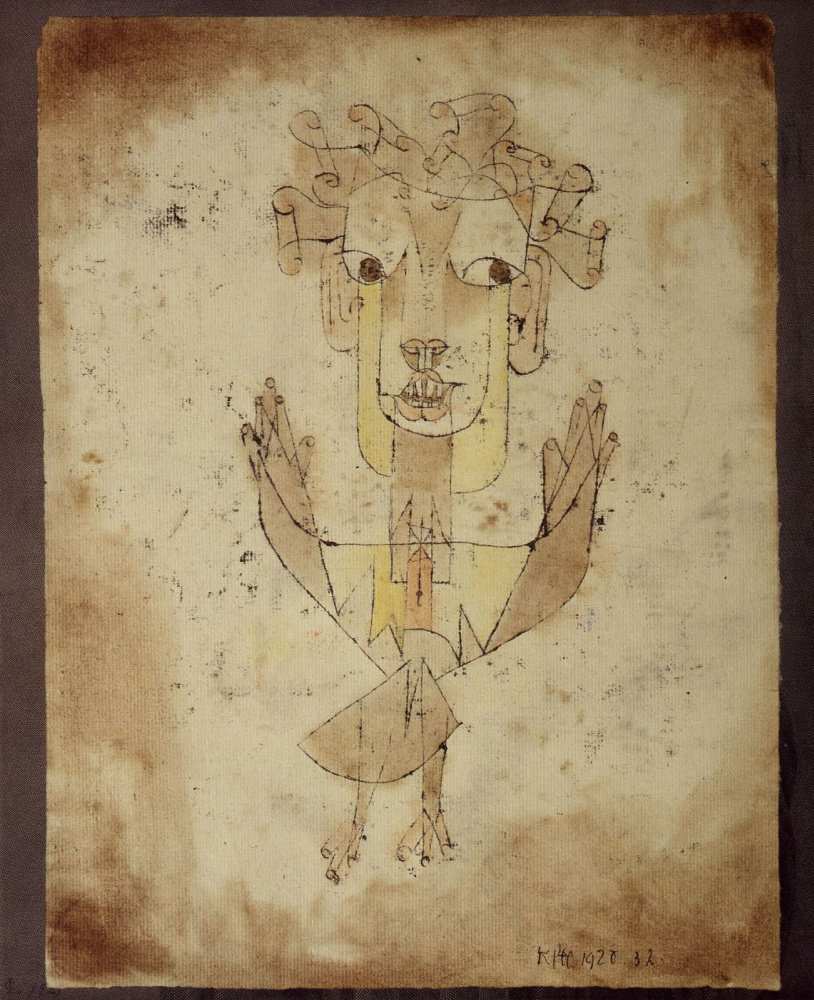log in
Enter site
Login to use Arthive functionality to the maximum
New angel (Angelus Novus)
Paul Klee • Painting, 1920
Description of the artwork «New angel (Angelus Novus)»
Unlikely the glue suggested and made all of those senses, which had grown for several decades his picture "New angel" (Angelus Novus). And hardly any of the paintings Klee got such a deep philosophical and cultural feedback from several of its holders. This is all the glue from one point on the canvas, he starts to live in a world that in the future no longer needed his leadership and imagination, and lives by himself, inland, incorporated in the laws. What happened next, Paul Klee would have liked.
They say that Walter Benjamin, a German Jew and a philosopher, never parted with this watercolor that I bought from the artist in 1921, immediately after creation. After 12 years of daily contemplation, he wrote about this painting a mystical work "Agesilaus Santander" and will always keep it before our eyes as a key image for reflection and a guide in the spiritual quest. This Benjamin called the clawed-angel lapago Klee's Angel of history and in one of his main books describe his movement through the terrible and the powerful metaphor: "Klee has a painting called Angelus Novus. It depicts an angel who looks like he is ready to part with something that stares. His eyes wide open, mouth rounded, and the wings straightened. Should look like the angel of history. His face turned to the past. Where for us the chain of upcoming events, where he sees a solid disaster continually gromozda the ruins over the ruins and it all falls down at his feet. He would have stayed to raise the dead and slap the debris. But a heavy wind rushing from heaven, fills his wings with such force that he no longer folded. The wind carries him irresistibly into the future to which he with his back turned, while the pile of debris before him rises to the sky. What we call progress is this storm".
After 1940, Walter Benjamin committed suicide in a small hotel, having been refused at the border and having lost all hope to emigrate from Nazi-occupied France, his Angelus Novus found another house, but it is still not known.
The new owner of the painting became Benjamin's friend Theodor Adorno, and later his another friend, one of the most famous Jewish philosophers, the researcher of the Kabbalah and honorary doctor of many universities around the world Gershom Scholem. Until his death Salema in 1982, a whopping 62 years after its creation, the painting could not see almost no one, but she was known in advance.
And while some critics and collectors rage in connection with undeserved fame, has fallen by Angelus Novus (say, the glory is not due to the artistic qualities of the picture, and the fictional), the work lived in the twentieth century a life which avant-garde artists in the 20 years I sincerely wanted.
Angelus Novus walked out one day and decided to choose his refuge, the national Museum of Israel.
Author: Anna Sidelnikova
They say that Walter Benjamin, a German Jew and a philosopher, never parted with this watercolor that I bought from the artist in 1921, immediately after creation. After 12 years of daily contemplation, he wrote about this painting a mystical work "Agesilaus Santander" and will always keep it before our eyes as a key image for reflection and a guide in the spiritual quest. This Benjamin called the clawed-angel lapago Klee's Angel of history and in one of his main books describe his movement through the terrible and the powerful metaphor: "Klee has a painting called Angelus Novus. It depicts an angel who looks like he is ready to part with something that stares. His eyes wide open, mouth rounded, and the wings straightened. Should look like the angel of history. His face turned to the past. Where for us the chain of upcoming events, where he sees a solid disaster continually gromozda the ruins over the ruins and it all falls down at his feet. He would have stayed to raise the dead and slap the debris. But a heavy wind rushing from heaven, fills his wings with such force that he no longer folded. The wind carries him irresistibly into the future to which he with his back turned, while the pile of debris before him rises to the sky. What we call progress is this storm".
After 1940, Walter Benjamin committed suicide in a small hotel, having been refused at the border and having lost all hope to emigrate from Nazi-occupied France, his Angelus Novus found another house, but it is still not known.
The new owner of the painting became Benjamin's friend Theodor Adorno, and later his another friend, one of the most famous Jewish philosophers, the researcher of the Kabbalah and honorary doctor of many universities around the world Gershom Scholem. Until his death Salema in 1982, a whopping 62 years after its creation, the painting could not see almost no one, but she was known in advance.
And while some critics and collectors rage in connection with undeserved fame, has fallen by Angelus Novus (say, the glory is not due to the artistic qualities of the picture, and the fictional), the work lived in the twentieth century a life which avant-garde artists in the 20 years I sincerely wanted.
Angelus Novus walked out one day and decided to choose his refuge, the national Museum of Israel.
Author: Anna Sidelnikova


